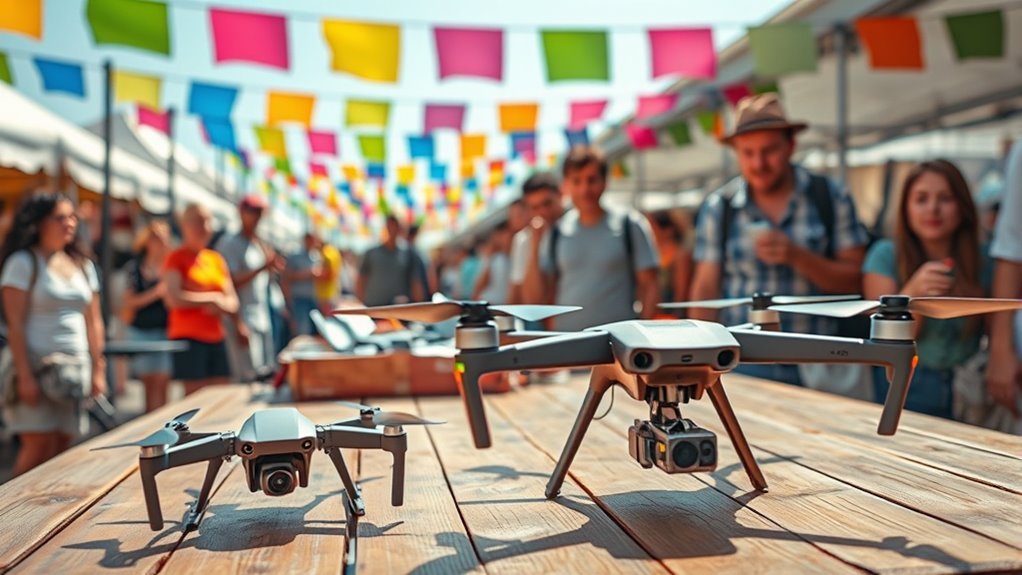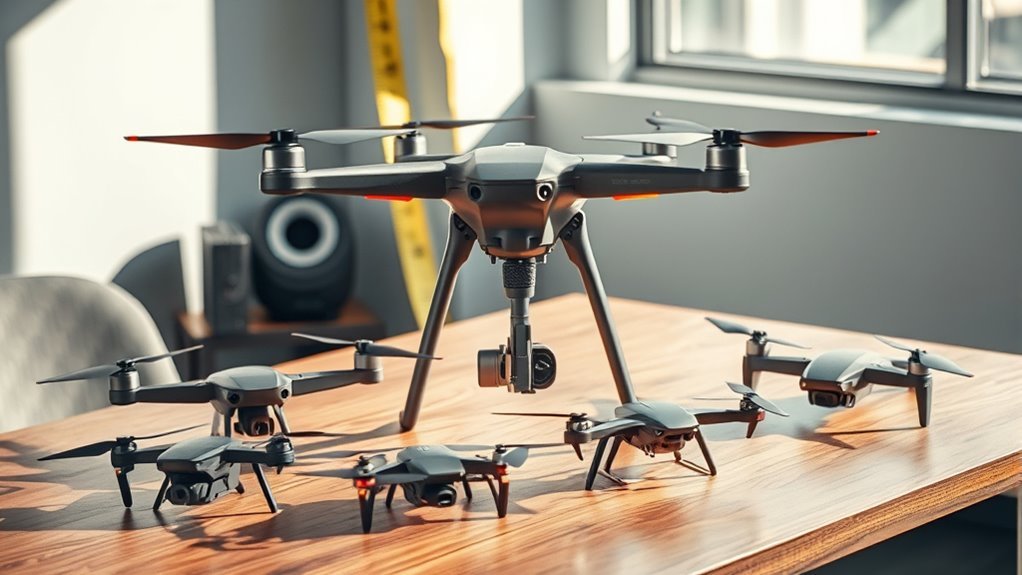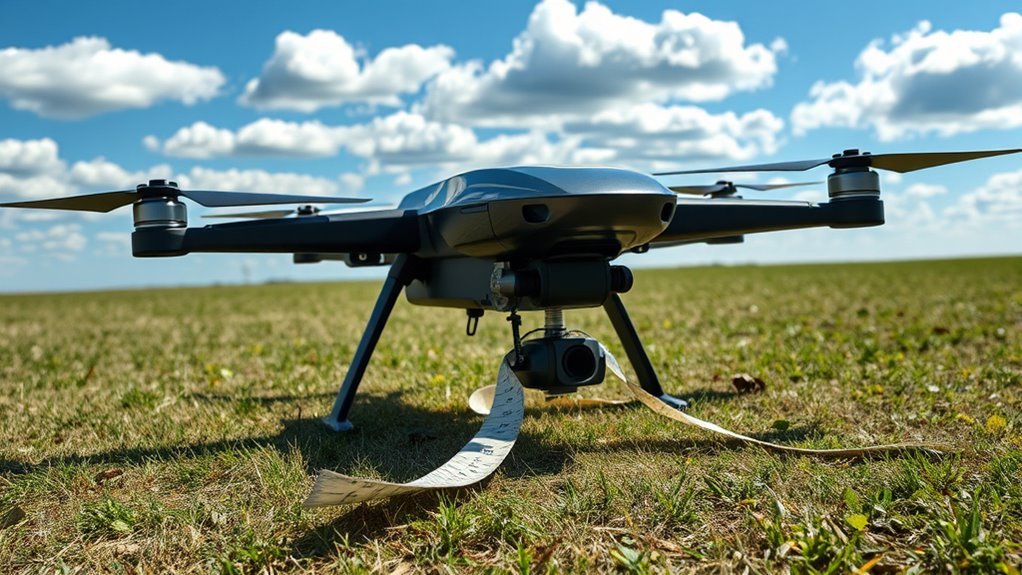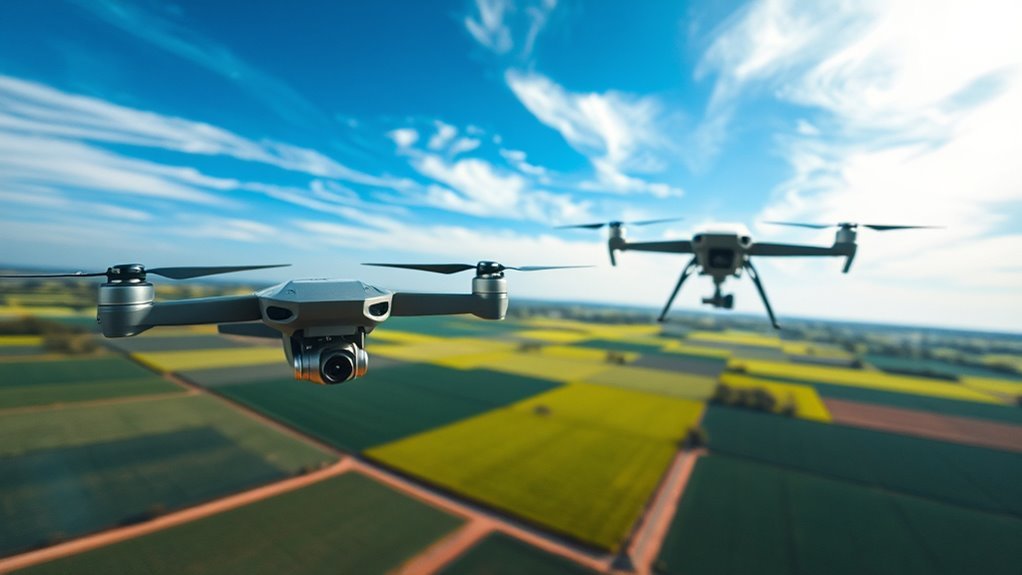When deciding how big a drone to buy, you should consider the size categories: small drones are under 250 grams, medium ones range from 250 grams to 2 kilograms, and large drones exceed 2 kilograms. Each category serves different purposes, with larger drones often offering advanced features. Keep in mind regulations and local laws that may affect your choice. The right drone size depends on your intended use, and there’s more to explore about making the best selection.
Understanding Drone Size Categories

When you’re considering a drone purchase, it’s essential to understand the various size categories that can greatly impact your flying experience and intended use. Drones come in different dimensions, and their weight classes play a significant role in performance, portability, and capabilities.
Small drones, typically under 250 grams, are perfect for casual users and ease of transport. Medium-sized drones, ranging from 250 grams to 2 kilograms, strike a balance between functionality and mobility, making them popular for both hobbyists and professionals. Larger drones, exceeding 2 kilograms, often carry advanced features and payloads, ideal for specialized tasks like aerial photography or surveying. For instance, larger drones may include advanced camera capabilities that enhance image quality and stability.
Recognizing these drone dimensions and weight classes can help you choose the right fit for your adventures and aspirations. Furthermore, understanding weight capacity constraints is crucial for optimizing your drone’s performance and ensuring safe operations.
Weight Restrictions and Regulations

When considering how big a drone you can buy, it’s vital to understand the weight restrictions set by the Federal Aviation Administration (FAA) and any local regulations. These rules not only dictate the maximum weight for recreational and commercial drones but also affect where and how you can fly them. Ignoring these guidelines could lead to fines or restrictions on your flying experience, so it’s important to stay informed.
Federal Aviation Administration Rules
Though you might be enthusiastic to take to the skies with your new drone, it’s crucial to understand the Federal Aviation Administration’s (FAA) weight restrictions and regulations that govern drone operations. If your drone weighs over 0.55 pounds, you’ll need to comply with drone registration requirements. This process guarantees your aircraft is tracked and responsible piloting is encouraged. Additionally, you’ll need to adhere to safety compliance guidelines, which include keeping your drone within visual line-of-sight and not exceeding a maximum altitude of 400 feet. These rules are designed not to restrict your freedom but to promote safe flying for everyone. So, before you launch into the air, make sure you’re well-informed about these crucial regulations.
Local Drone Regulations
How do local drone regulations affect your flying experience? Understanding these rules is essential for any drone enthusiast seeking freedom in the skies. Local regulations can impose weight restrictions and specific drone registration requirements that vary by area. Here’s what you need to know:
- Check local weight limits to avoid penalties
- Know your drone registration requirements before flying
- Be aware of no-fly zones in your vicinity
- Understand local enforcement practices to stay compliant
- Stay updated on changing regulations to keep flying freely
Local Laws and Airspace Considerations

Before you purchase a drone, it’s vital to understand the local laws and airspace considerations that could impact your flying experience. Different regions have specific drone registration requirements, and failing to comply can lead to hefty fines. Knowing where you can fly is equally important; the airspace classification systems dictate whether you’re in controlled or uncontrolled airspace. In controlled zones, you may need special permissions or licenses, while uncontrolled areas might offer more freedom. Always check local regulations, as they can vary widely and affect your drone’s size and capabilities. By staying informed, you can enjoy the thrill of flying while respecting the rules that keep the skies safe and accessible for everyone. Additionally, be aware of temporary flight restrictions that may affect your planned flying area. Understanding drone registration requirements is essential for compliance and avoiding legal issues.
Purpose of Use: Recreational vs. Commercial
Understanding local laws and airspace considerations leads you to another important factor when choosing a drone: the purpose of use, whether for recreational or commercial activities. Your choice can dictate the drone’s size, features, and capabilities.
Consider these points:
- Recreational drones are typically lighter and easier to fly.
- Commercial drones often require advanced technology for specific tasks, such as autonomous navigation systems that enhance operational efficiency.
- Regulations differ; commercial use usually has stricter rules.
- Think about your long-term goals—will you want to shift from fun flying to professional work?
- Budget plays a role; commercial drones can be pricier due to their capabilities.
- For example, the sanitization performance of commercial drones like the Lucid Sanitization Drone can significantly enhance operational efficiency.
Ultimately, aligning your drone with your intended purpose guarantees you get the best experience, whether you’re capturing stunning landscapes or conducting aerial surveys.
Battery Life and Flight Time Implications
When selecting a drone, battery life and flight time are essential factors that can greatly impact your flying experience. Understanding battery technology is vital, as it determines your drone’s flight endurance. A longer flight time means more freedom to explore and capture stunning aerial footage without constant interruptions. Additionally, the choice of drone may influence overall performance, as models like the Draganfly X4-ES offer superior battery life compared to others in its class, with the Autel EVO Lite+ V2 providing up to 40 minutes of flight time.
| Battery Type | Flight Time |
|---|---|
| LiPo (Lithium Polymer) | 20-30 minutes |
| Li-ion (Lithium-Ion) | 15-25 minutes |
| NiMH (Nickel-Metal Hydride) | 10-15 minutes |
| Lead Acid | 5-10 minutes |
Choosing the Right Drone for Your Needs
How do you determine which drone best suits your needs? Start by considering your primary purpose for flying. Here are some key factors to keep in mind:
- Drone features: Identify the functionalities you need, like GPS, obstacle avoidance, or follow-me modes. Many modern drones also come equipped with intuitive controls to enhance user experience and ease of use.
- Camera quality: Decide if you need a high-resolution camera for photography or video.
- Flight range: Think about how far you want to fly from your starting point.
- Portability: Consider how easy it is to transport the drone.
- Budget: Set a realistic budget and find options that fit without compromising essential features. Additionally, keep in mind the importance of battery life as it can greatly affect your flying experience.
Frequently Asked Questions
What Are the Largest Drones Available for Consumer Purchase?
You’ll find consumer drones up to 55 pounds, offering impressive capabilities for photography and mapping. However, you’ll need to navigate regulations, ensuring compliance for safe operation while maximizing your creative freedom.
Can I Customize the Size of My Drone?
You can customize your drone’s size through various modifications, but there are size limitations based on regulations and design. Always check local laws to verify your modifications comply, maintaining both safety and your creative freedom.
How Do Drone Sizes Affect Repair Costs?
When it comes to your drone, size can be a double-edged sword. Larger drones often mean higher repair cost factors due to more expensive parts and complexity, while smaller ones can be easier and cheaper to fix.
What Materials Affect a Drone’s Size and Weight?
Drone materials like carbon fiber or plastic greatly influence size and weight distribution. Lighter materials enhance maneuverability, while heavier ones may provide stability. Understanding these factors helps you choose a drone that suits your flying freedom.
Are Larger Drones Harder to Transport?
Yes, larger drones often present transportation challenges. Their size can hinder portability, making them cumbersome to carry. You’ll need to take into account storage options and vehicle space to guarantee you can transport your drone easily.

